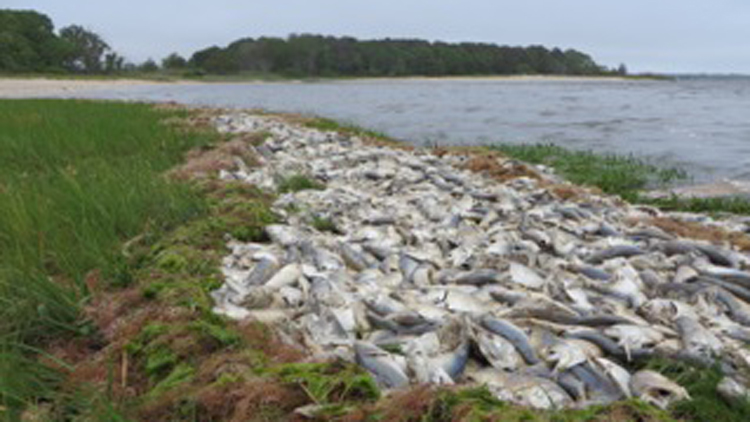Thousands of dead bunker fish were found on the shores of Flanders Bay last weekend, two weeks after hundreds of diamondback turtles washed up dead nearby, raising serious environmental concerns on the East End.
Preliminary tests suggest that both mass die-offs may be linked to a recent red tide, a condition created by an excess of algae in the water that studies have shown is caused by increased nitrogen levels stemming from septic systems, storm-water runoff and sewage plants. The turtles are believed to have eaten shellfish made poisonous by the algae bloom, and the fish appear to have suffocated because the water had low oxygen level as a result of the red tide, experts said.
“Unfortunately, in a situation where oxygen is already suppressed and a large amount of fish [are present], there isn’t enough oxygen for the fish to survive,” said Kevin McAllister, a marine biologist who is founding president of Defend H2O, a nonprofit environmental group. “We’ve reached the tipping point of too much nitrogen and now we’re seeing problems with our water bodies.”
The New York State Department of Environment and Conservation (DEC) determined that the fish kill was a result of hypoxia, the medical term for oxygen deprivation. The agency also preliminarily determined that the turtles were poisoned by saxitoxin, a toxic byproduct from algae consumed by the shellfish that the diamondbacks eat, although the DEC is awaiting the results of further tests to be sure.
Shortly before the die-offs, increased saxitoxin levels prompted the DEC to issue a ban on shellfish harvesting in Meetinghouse Creek and Terry Creek, both tributaries of Flanders Bay, and James Creek, a tributary of Great Peconic Bay.
Bunker fish, which often swim in extremely large schools, tend to consume large amounts of oxygen, meaning they may have hastened their own demise, environmental experts said. Low dissolved oxygen levels are common for the summer months in the area due to the sudden rise in water temperatures, but fish kills are still taken seriously.
Mass marine-life die-offs are not uncommon in Long Island waters, but these back-to-back events made the region take notice. Among recent events were hundreds of dead bluefish were that washed up in Mecox Bay two years ago. That case was blamed on low water temperatures.
“Such occurrences will become the norm if we don’t reduce 30-50 percent of the nitrogen going into the Peconic Estuary,” said Kevin McDonald of The Nature Conservancy on Long Island, in a statement. “While some strides have been made to reduce nitrogen in our waters, the longer we wait to fix our water quality problems, the worse it will get, the longer it will take and the more expensive it will be.”
Some people were awaiting more information before they could be sure there is a clear link. Karen Testa, the executive director of the Turtle Rescue of the Hamptons, said that she wants to see pathology test results performed on turtles and fish by scientists at Cornell University so she can definitively know whether there is a connection.
The DEC is encouraging community members to report any additional fish kills or other marine life problems by calling 631-444-0430 or emailing FW.Marine@dec.ny.gov with the subject line “fish kill.”

































